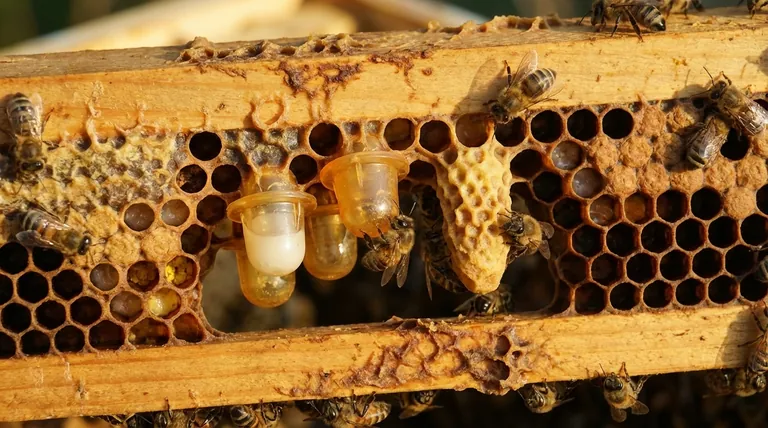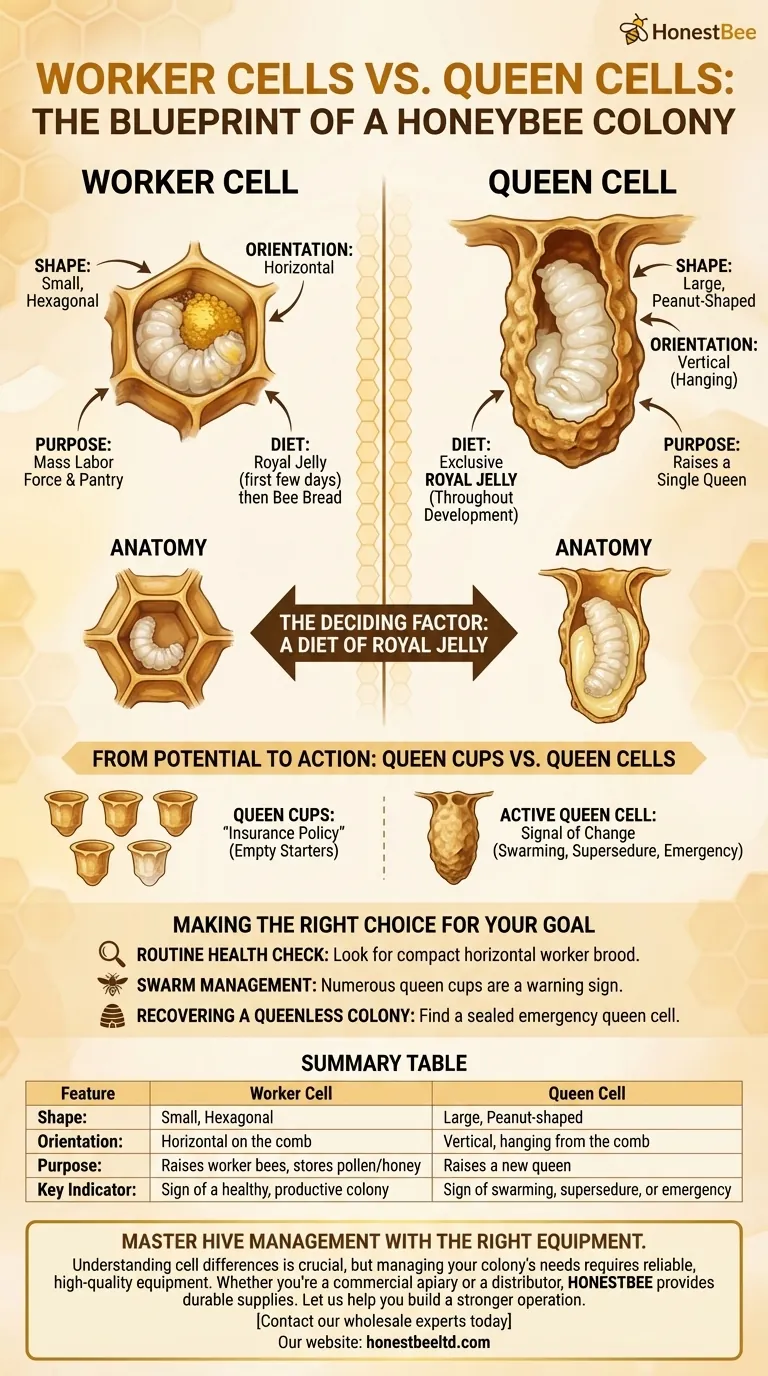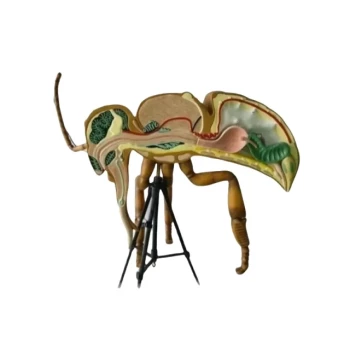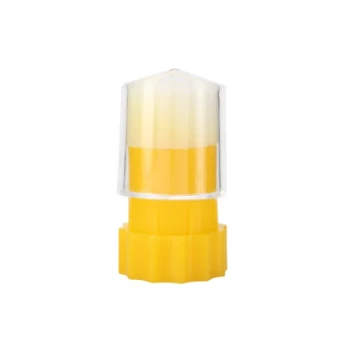The fundamental difference between queen cells and worker cells lies in their size, shape, and orientation within the hive. Worker cells are small, hexagonal, and built horizontally into the comb, while queen cells are significantly larger, peanut-shaped, and hang vertically from the comb. This structural difference dictates the developmental path of the bee within.
The cell is more than just a container; it is the physical blueprint for a bee's destiny. A worker cell is designed for mass production of the labor force, while a queen cell is a specialized chamber built exclusively to nurture a colony's single most vital member.

The Anatomy of the Cell: Form Follows Function
The design of each cell type is precisely engineered to meet the needs of the bee that will develop inside it. Understanding these designs is key to interpreting the health and intentions of a colony.
Worker Cells: The Hexagonal Engine of the Hive
A standard worker cell is a marvel of efficiency. Its hexagonal shape allows for the maximum number of cells to be built using the least amount of wax.
These cells are built horizontally and are used for multiple purposes. They are where the queen lays fertilized eggs that become female worker bees, and they also serve as the hive's pantry for storing both pollen and honey.
The smaller size of the worker cell is intentional. It ensures the developing larva receives the standard diet required to become a worker, not a queen.
Queen Cells: The Cradle of Royalty
In stark contrast, a queen cell is built for a single, critical purpose: to raise a queen. They are easily identifiable by their unique appearance.
Their shape is often described as looking like a peanut shell, and they are much larger than any other cell in the hive. This extra space is necessary to accommodate the development of a larger, reproductively mature bee.
Most importantly, queen cells hang vertically from the surface or bottom of the comb. This orientation is a clear visual indicator that the colony is investing in new royalty.
The Deciding Factor: A Diet of Royal Jelly
The cell's structure is only half the story. The true trigger for queen development is diet.
A larva in a queen cell is fed exclusively on a rich, protein-packed substance called royal jelly throughout its development. Larvae in worker cells receive this special diet for only the first few days before being switched to a mixture of pollen and nectar known as "bee bread."
The queen cell's large size ensures the larva is bathed in this substance, enabling its transformation into a queen.
From Potential to Action: Queen Cups vs. Queen Cells
Not all queen-like cells are a sign of an imminent new queen. Beekeepers must distinguish between a state of readiness and a state of action.
Queen Cups: An Insurance Policy
Colonies often build queen cups, which are small, downward-facing, cup-shaped wax structures. These are essentially empty starter cells.
Their presence is normal and can be thought of as the colony's "insurance policy." They are placeholders, ready to be used if the colony suddenly needs to raise a new queen.
Active Queen Cells: A Signal of Change
A queen cup becomes an active queen cell only when the queen lays an egg inside it and the workers begin to draw it out and fill it with royal jelly.
Seeing a fully developed, sealed queen cell is a definitive sign that the colony is in the process of replacing its current queen. This may be due to swarming (reproduction), supersedure (old or failing queen), or an emergency (sudden loss of the queen).
Making the Right Choice for Your Goal
Interpreting the cells in your hive is a fundamental beekeeping skill that informs your management decisions.
- If your primary focus is a routine health check: Look for frames filled with compact, horizontal worker brood, which indicates a healthy and productive queen.
- If your primary focus is swarm management: The appearance of numerous queen cups, especially along the bottom of frames, is your first warning sign to take preventive action.
- If your primary focus is recovering a queenless colony: Finding a sealed, viable emergency queen cell is a sign that the bees have already put a solution in motion.
Ultimately, reading the comb is like reading the colony's mind, and the difference between a worker cell and a queen cell tells you everything about its present state and future intentions.
Summary Table:
| Feature | Worker Cell | Queen Cell |
|---|---|---|
| Shape | Small, Hexagonal | Large, Peanut-shaped |
| Orientation | Horizontal on the comb | Vertical, hanging from the comb |
| Purpose | Raises worker bees; stores pollen/honey | Raises a new queen |
| Key Indicator | Sign of a healthy, productive colony | Sign of swarming, supersedure, or emergency |
Master Hive Management with the Right Equipment
Understanding cell differences is crucial, but managing your colony's needs requires reliable, high-quality equipment. Whether you're a commercial apiary focused on maximum production or a distributor supplying beekeepers, HONESTBEE provides the durable, efficient beekeeping supplies you need to succeed.
Let us help you build a stronger operation. Contact our wholesale experts today to discuss your specific needs and how our products can support your goals.
Visual Guide

Related Products
- JZBZ Push-In Queen Cell Cups for Beekeeping
- Brown Nicot Queen Cell Cups for Breeding Queen Bees Beekeeping
- Wood and Mesh Push-In Queen Cage
- Plastic Chinese Queen Grafting Tool for Bee Queen Rearing
- Professional Queen Catcher and Introduction Queen Cage
People Also Ask
- How should the cells be culled after grafting? Maximize Queen Quality with Strategic Culling
- What are the signs that a queen cell is about to emerge? Master the Critical Timing for Hive Success
- What happens when a queen cell is introduced into a queenless colony? Ensure Successful Requeening
- What should be done with extra queens from grafting? A Strategic Guide for Apiary Management
- Why is it important to select a healthy larva less than 24 hours old for queen rearing? Maximize Queen Quality and Colony Strength



















